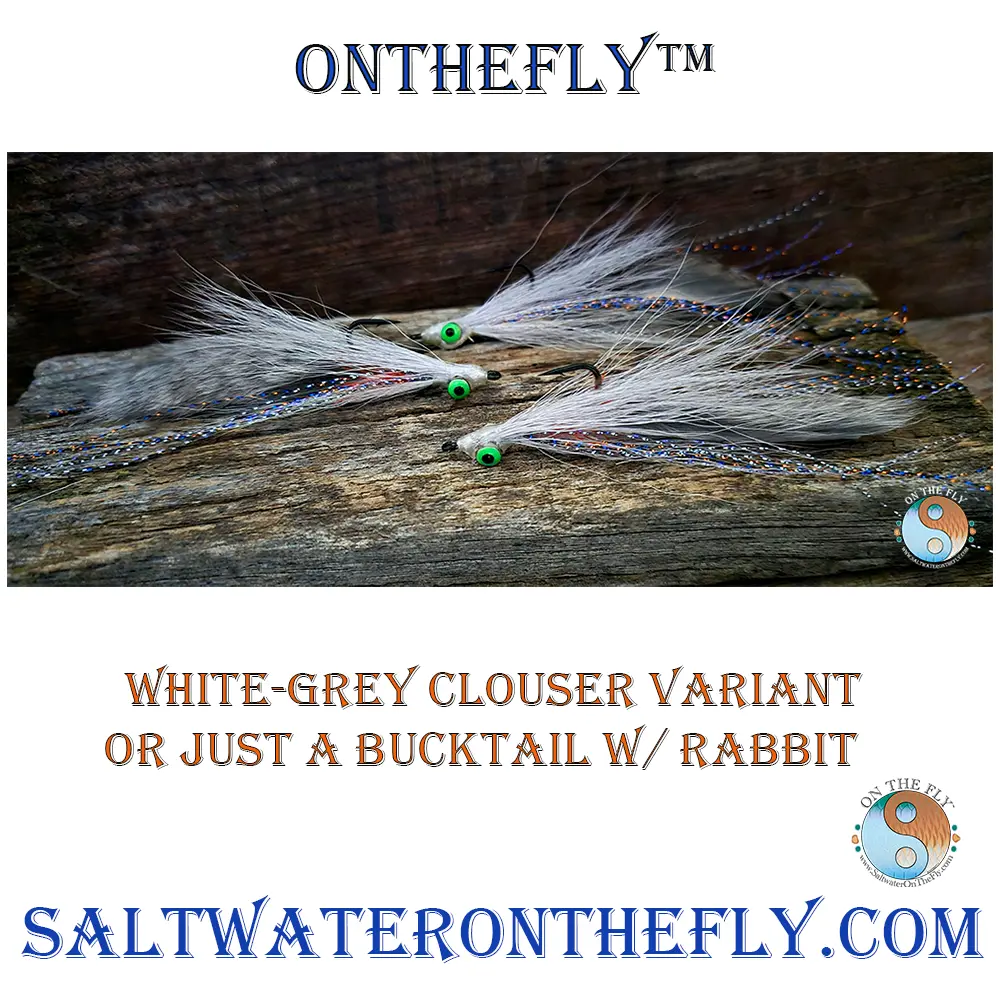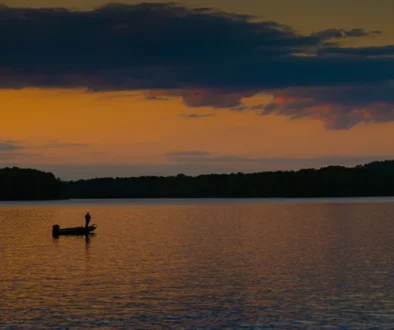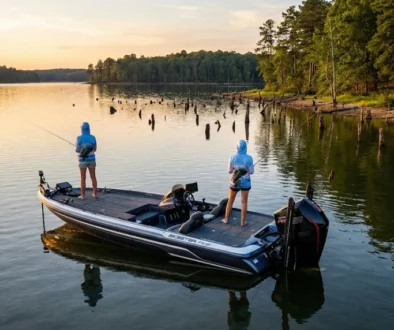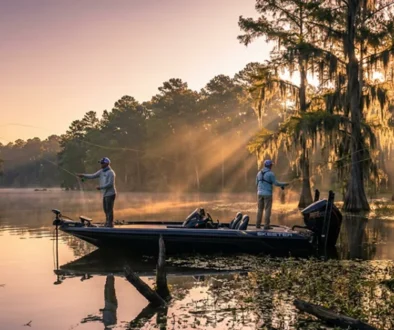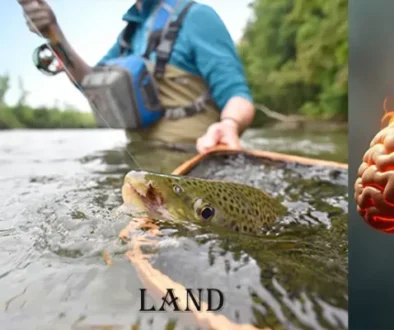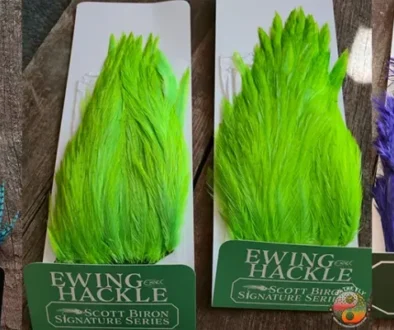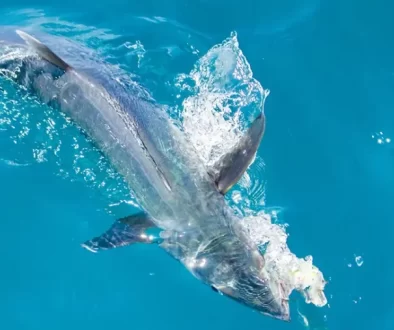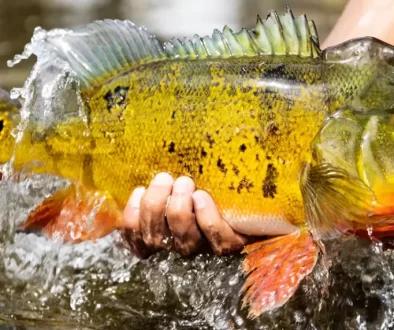Have you ever felt the exhilarating tug of a northern pike at the end of your fly line? That adrenaline rush as it thrashes, testing every bit of your gear and angling skills?
I have. Nada can compare to that electrifying thrill when the fish is puttin’ up a fight!
So, what’s the next step? How can I experience that heart-stopping moment when a big fish strikes my fly?
This is where we start our journey…
Welcome to How to Start Fly Fishing for Pike, an adventure filled with cunning adversaries (pike aren’t called ‘water wolves’ for nothing), exotic gear (ever heard about dragon tail flies?), and unforgettable experiences (like seeing a pike leap out of water).
Alright, let’s cast on.
Table Of Contents:
- Understanding Pike Behavior and Habitat
- Choosing Your Fly Fishing Gear for Pike
- Selecting Flies for Pike Fishing
- Techniques for Fly Fishing for Pike
- Safety Measures When Fly Fishing for Pike
- Comparing Pike to Other Fish Species
- Reviewing Essential Gear For Pike Anglers
- FAQs in Relation to How to Start Fly Fishing for Pike
- Conclusion of How to Start Fly Fish for Pike
Understanding Pike Behavior and Habitat
Pike, or as I like to call them – the torpedo of freshwater fishing, have quite a peculiar behavior. They’re often found basking in sunshine, lounging around sluggish streams and shallow weed beds. But don’t let this lazy demeanor fool you. These critters can turn into speedy predators at the sight of potential prey.
Recognizing Pike Territory
If you want to get on a pike’s good side (which is anywhere outside their mouth), understanding where they hang out is crucial. You see, these fish are pretty much aquatic sunbathers; they love soaking up some rays. And guess what? Shallow waters with plenty of sunlight offer prime tanning spots for our toothy prey.
Their preferred habitat includes everything from lagoons and lakes filled with aquatic grasses to slower moving rivers. Just think about places where water warms faster when Mr.Sun shows his face – that’s your target area.
And it’s not just about being solar-powered swimming machines either. These areas provide excellent hunting grounds for pikes because their prey tends to gather here too.
This preference for warm shallow water might be surprising given that many associate pikes with deeper regions. Well, welcome to the world of unexpected piscatorial facts fellow stalker.
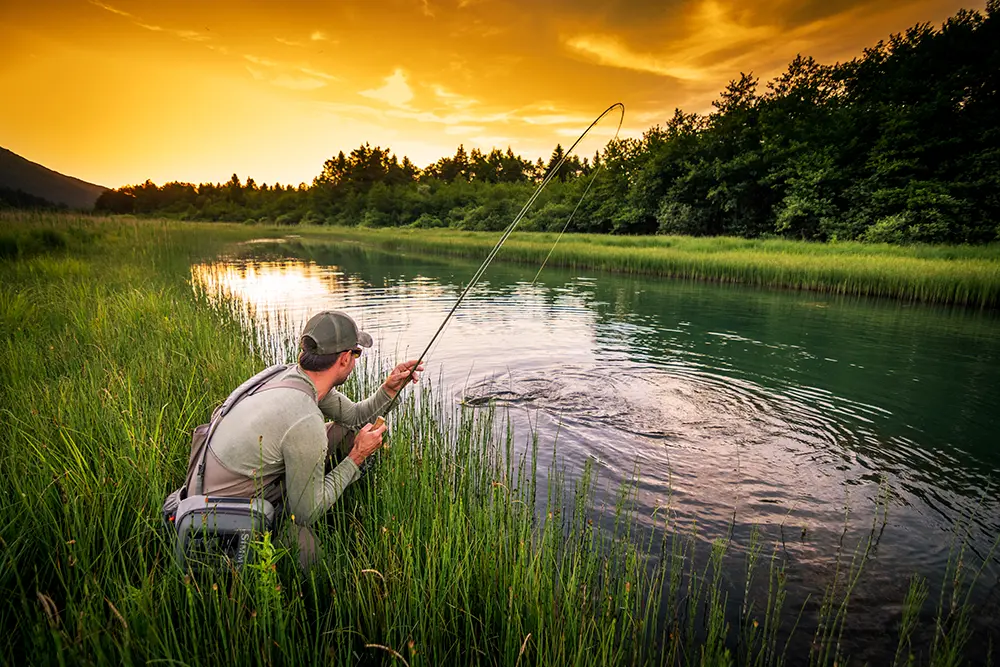
Finding The Sunlit Goldilocks Zone For Pike Fishing
You know how people say “there’s always one”? In case of northern pike, there seems to be an entire species worth. While most other fishes prefer cooler depths during sunny hours, these guys stay near surface enjoying every bit of warmth available. So while targeting them using fly rods make sure you’re aiming closer towards the surface rather than sinking your line into the depths.
That’s not to say pike won’t venture deeper, but their affinity for sunlit shallows provides an excellent opportunity for us fly fishers. To get more insight on this behavior and how it affects fishing strategies, check out The Most Pristine Trout Fisheries in the World.
Finding The Sunlit Goldilocks Zone For Pike Fishing
You know how people say “there’s always one”? In case of northern pike, there seems to be an entire species worth. While most other fishes prefer cooler depths during sunny hours, these guys stay near surface enjoying every bit of warmth available. So while targeting them using fly rods make sure you’re aiming closer towards the surface rather than sinking your line into the depths.
That’s not to say pike won’t venture deeper, but their affinity for sunlit shallows provides an excellent opportunity for us fly fishers. To get more insight on this behavior and how it affects fishing strategies, check out The Most Pristine Trout Fisheries in the World.
Predatory Habits of Pike
Pikes predatory habits are very opportunistic. Lay in waiting for that unsuspecting duckling to swim over, hence nick name water wolf.
Choosing Your Fly Fishing Gear for Pike
Before you can start making those long, graceful casts into the water to catch pike, you’ll need to gear up. But don’t fret; I’ve got your back. This is where years of my personal fly fishing experience come in handy.
The first item on our list is the rod. When it comes to catching northern pike or any big fish for that matter, a heavier rod gives an edge. In my book and many others’, a 10wt fly rod stands out as a top choice for handling these hard-hitting bruisers.
You’re also going to need a line that lets your flies swim just right in different parts of the water column. For this task, nothing beats floating or intermediate sinking lines. These allow flexibility when presenting large surface flies or dredging deeper water where the big ones lurk.
Speaking of depth and presentation, understanding how various sink rates influence where your fly swims is key – from shallow weed beds favored by sun-loving pikes down to colder depths during hot days. Don’t let temperature changes throw off your game.
Picking The Right Leader Material
No one likes losing their prized bait fish imitations mid-cast due to flimsy leader material (trust me.). Here’s some wisdom: Invest in sturdy wire leaders such as Cortland’s Tie-Able Stainless Steel Leader Material. A 65lb wire leader should suffice – strong enough not only against sharp teeth but more importantly against powerful runs and sudden lunges common with pike fights.
Talking Flies And Patterns
Moving on to flies, you’ll want an arsenal that mimics the food pike eat. From smaller fly patterns resembling local baitfish and fry up to big flies like tube fly imitations of larger prey – variety is your friend.
Here’s a tip I’ve picked up: always have some wiggle tail or dragon tail patterns at the ready. Pike are visual hunters and they can’t resist flashy, moving targets. The more movement, the better.
Learn to Fly Fish for Pike from a Guide
Take a trip locally or a great get away to Denmark. Fish the surf for sea trout and inland lakes for trophy pike.
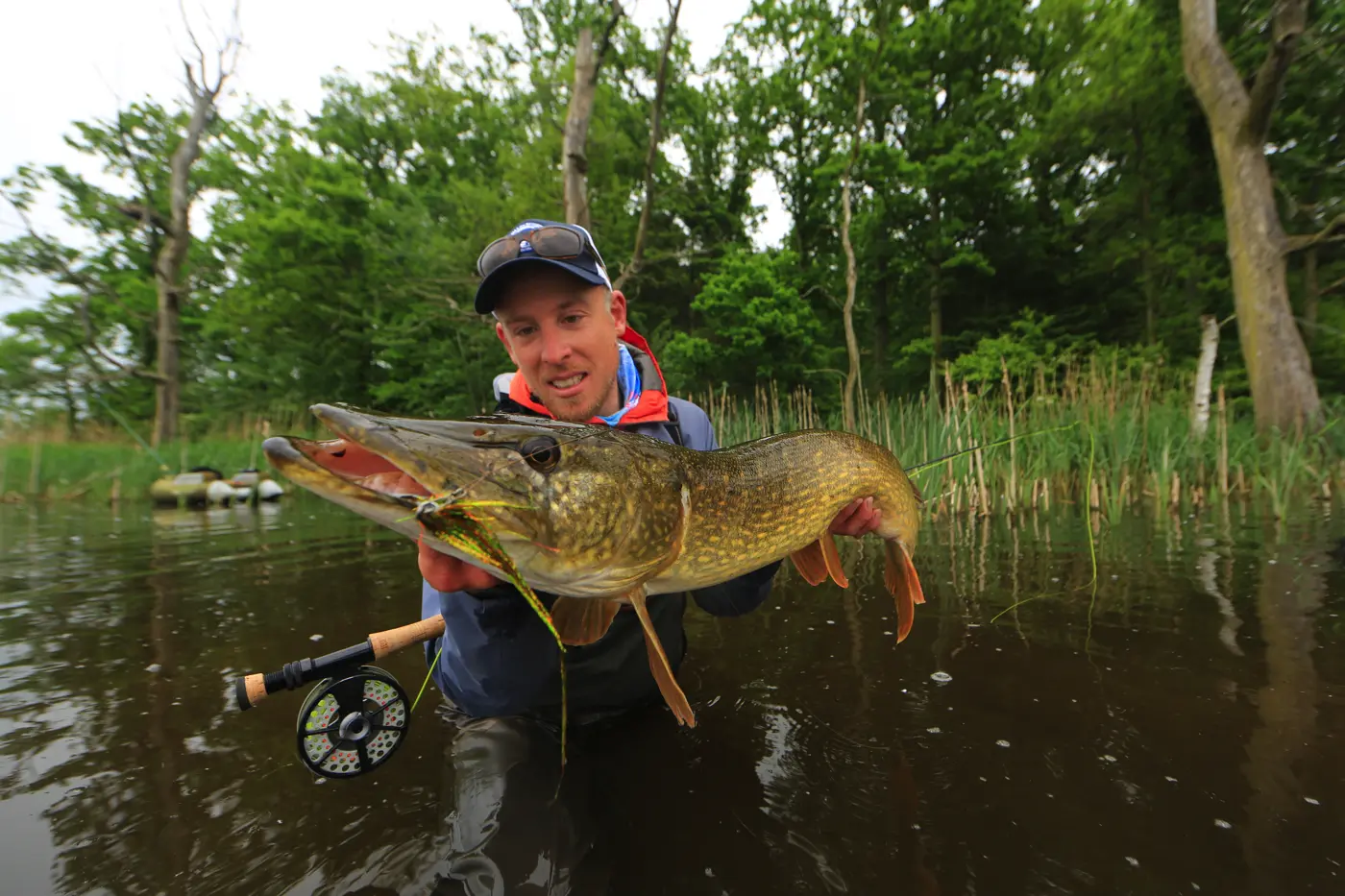
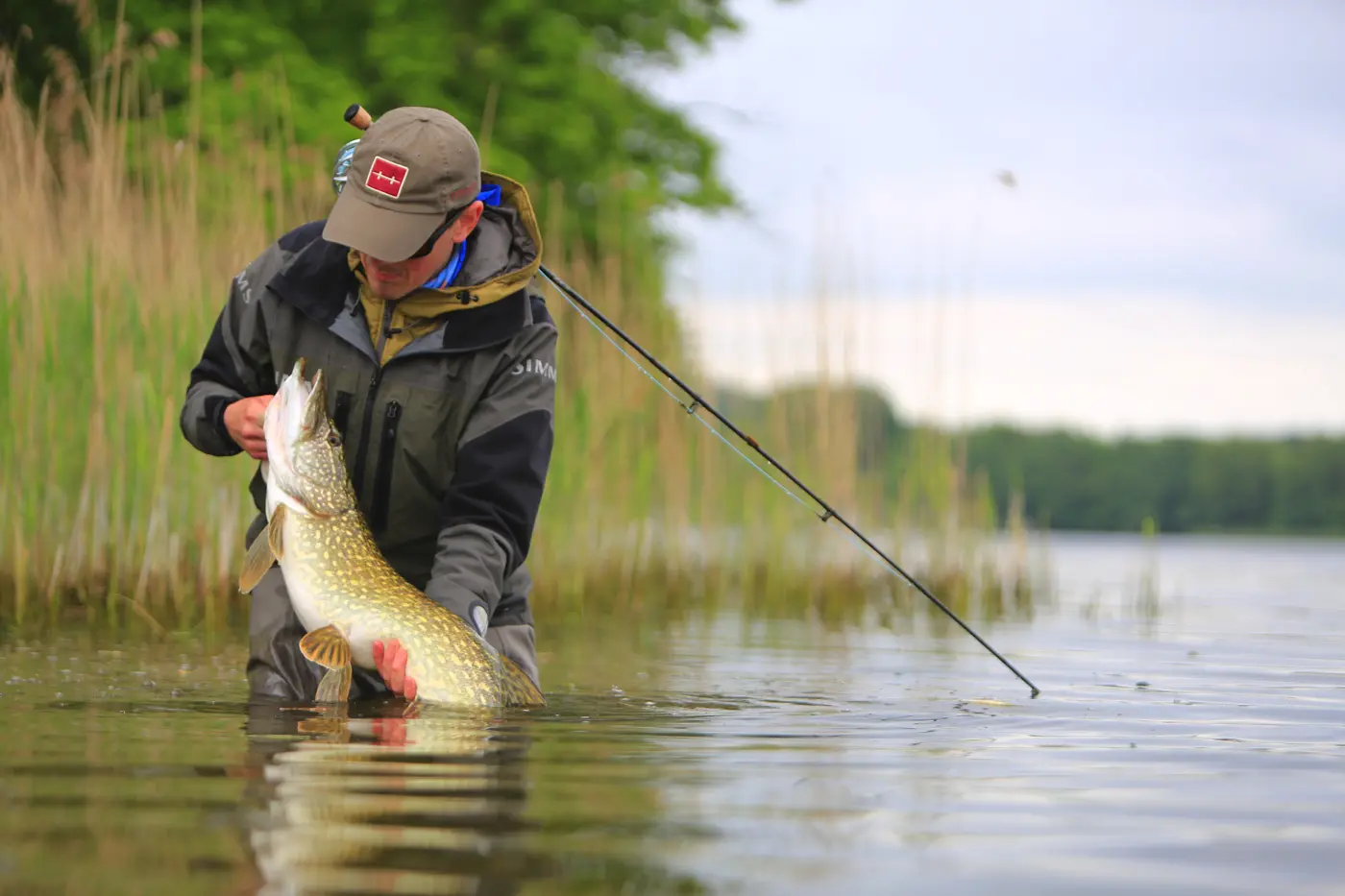
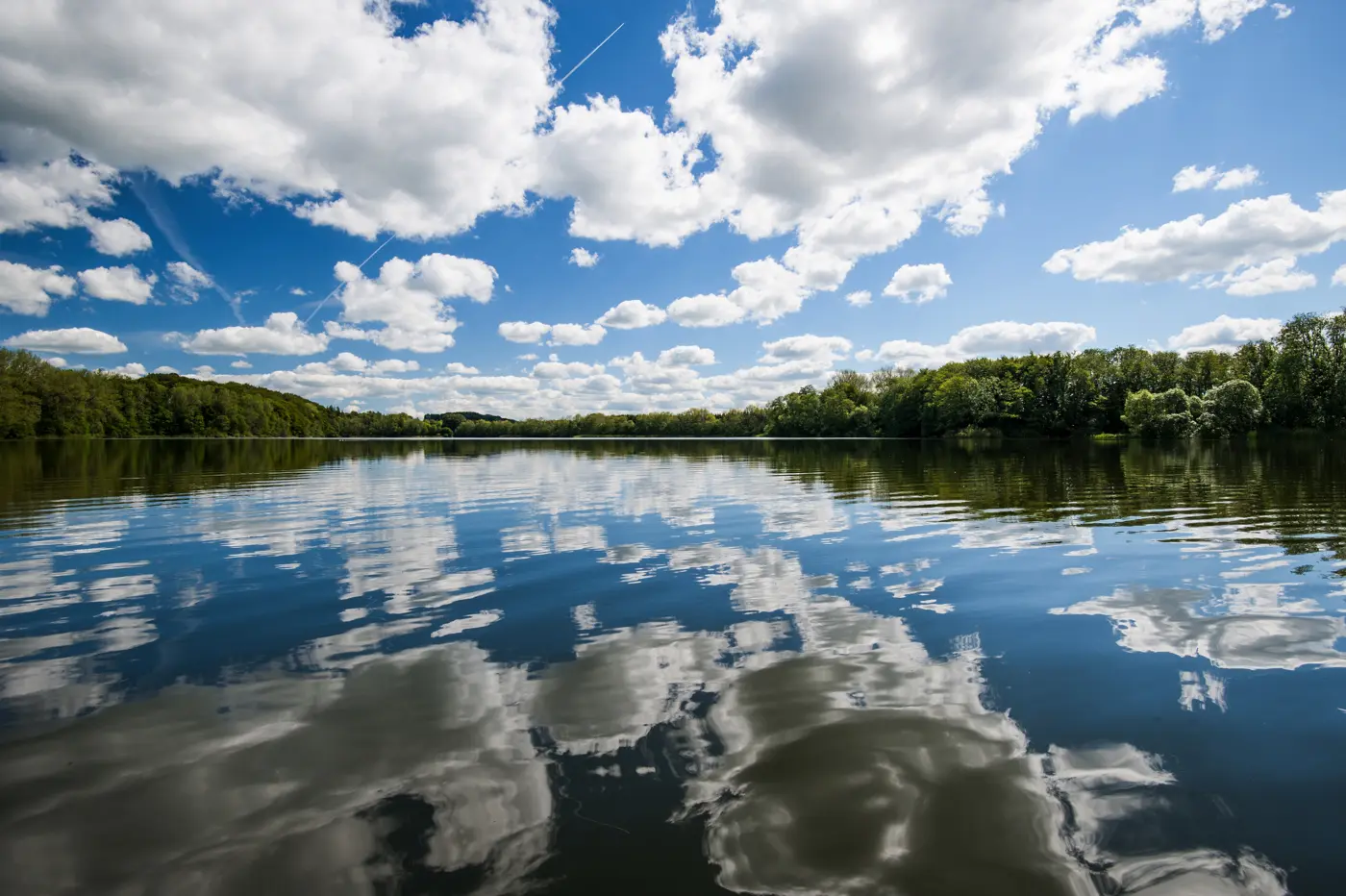
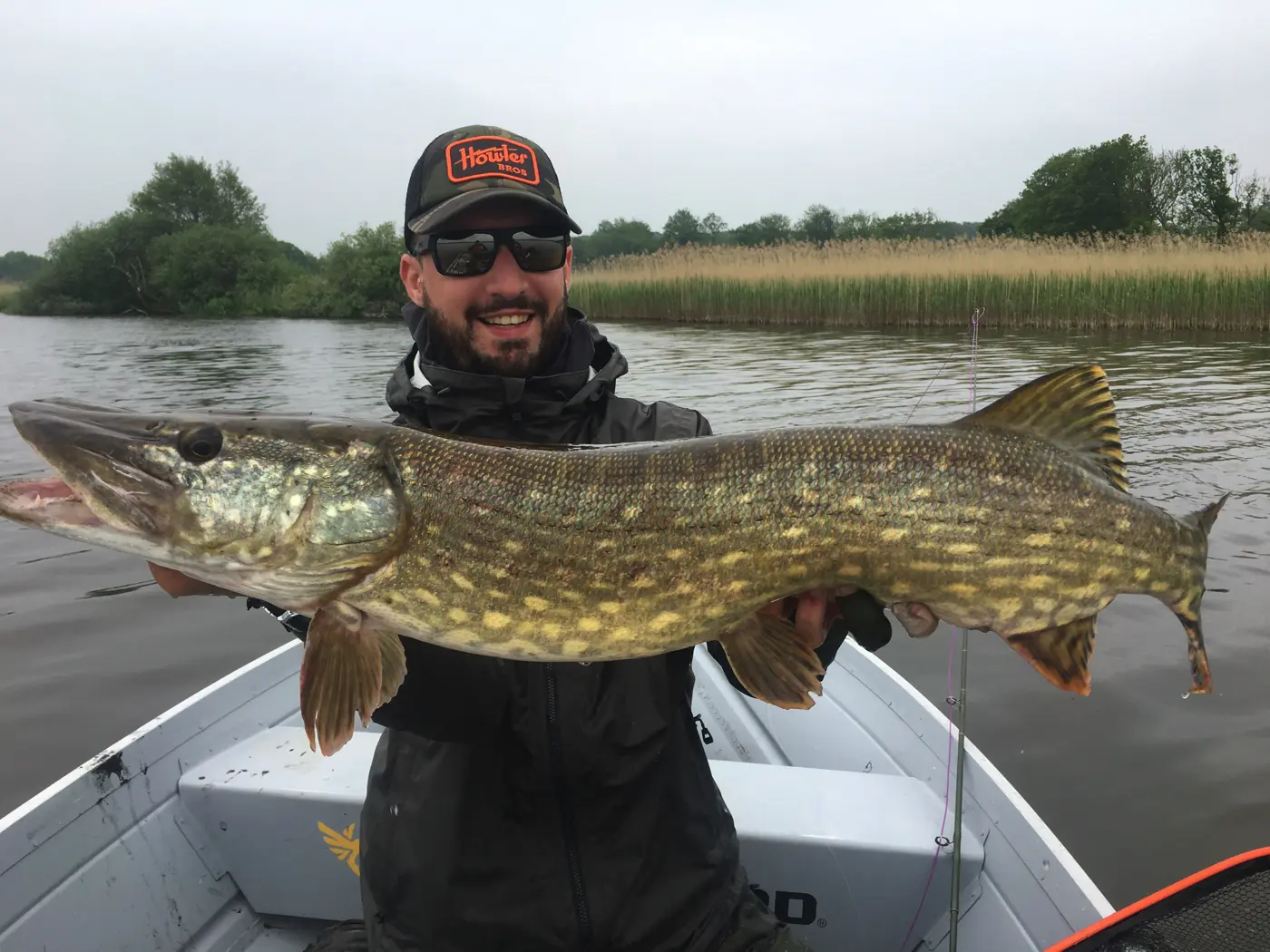
Selecting Flies for Pike Fishing
So, you’re ready to tackle pike fishing with a fly rod? That’s fantastic. The thrill of hooking into a big northern pike on the end of your line is second to none. But remember, success in catching these ferocious predators lies largely in selecting the right flies.
The first thing that comes up when we talk about flies for pike is their size. A general rule of thumb – bigger can be better. Most seasoned anglers agree that flies used to target pike range from 6-18 inches in length. Though I have caught them on size 4 woolly buggers.
Below are a few patterns I use for pike and other predatory fish learn more see complete collect click here.
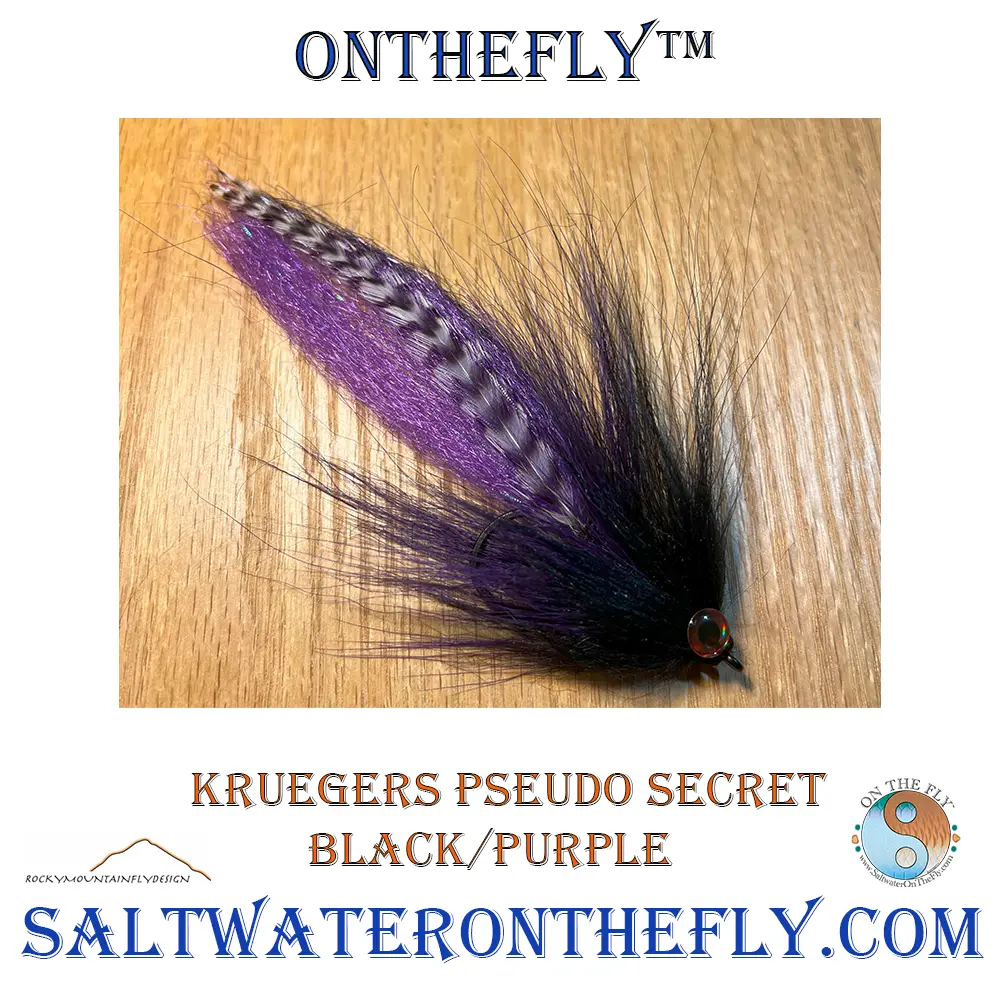
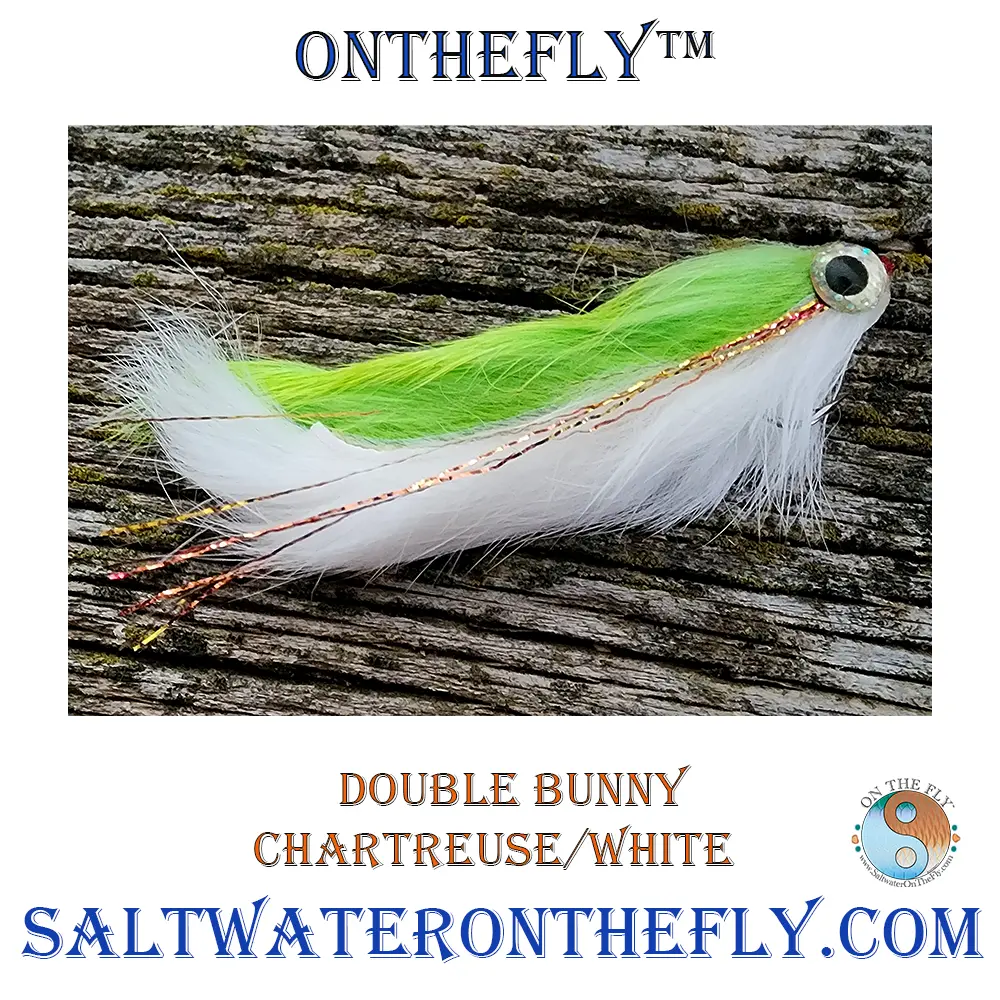
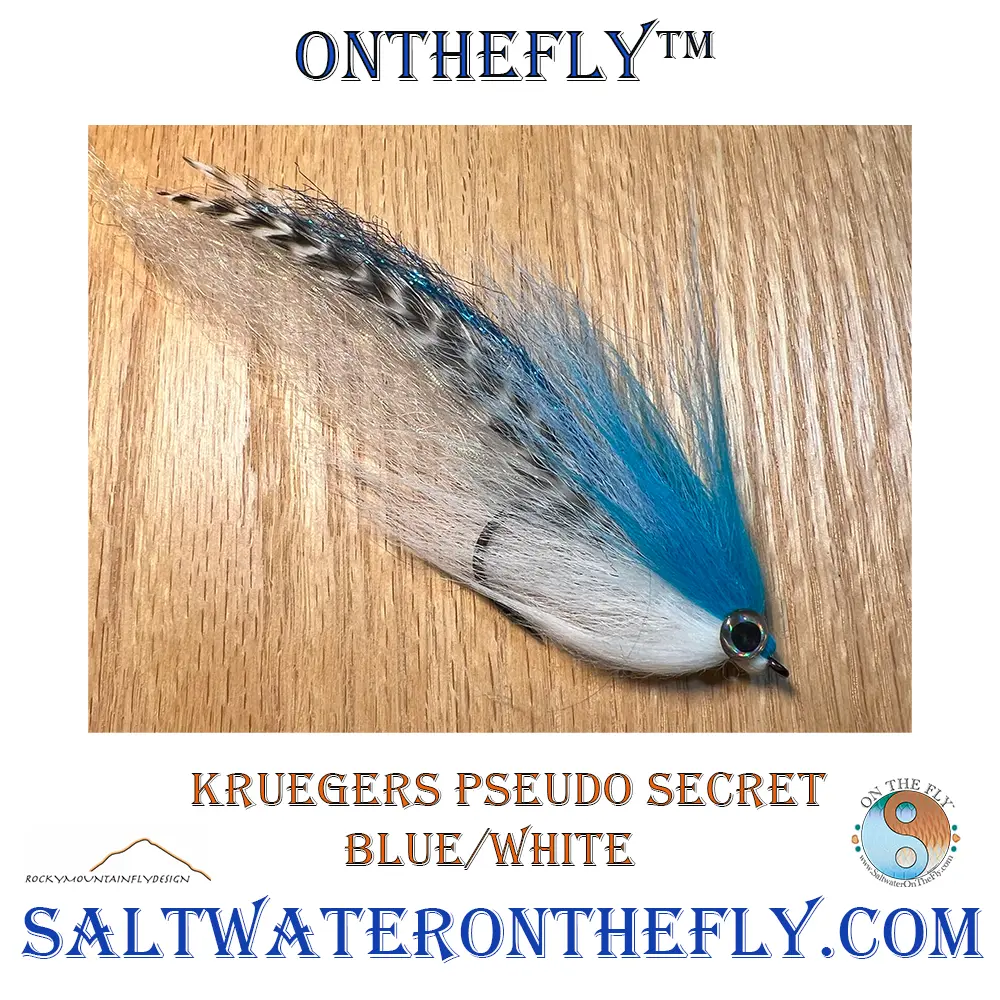
Understanding the Use of Streamer Flies
Fly patterns are important too; they should resemble food items common in waters where you fish or have enough flash and wiggle tails action to provoke an attack from curious pikes lurking nearby.
Predatory by nature, northern pikes often go after streamer flies due to their similarity with small bait fish swimming through water columns. Not only do they closely mimic what actual prey would look like underwater but also move just as erratically.
This said, don’t underestimate topwater patterns either – mice, frogs, poppers…you name it. Pikes love them all because they replicate animals struggling at the surface which makes an easy meal (and exciting strikes.).
If your quarry still doesn’t bite despite using larger lures then consider downsizing instead—a smaller fly might trigger its interest more than a gigantic one staring back defiantly. So make sure you’ve got variety stocked up before hitting those prime spots where big fish lurk.
Tips for Tying Your Own Pike Flies
If you’re feeling a bit crafty and want to tie your own pike flies, remember these tips. Pike are attracted to shiny objects so don’t shy away from using flashy materials like deer hair or cone head for tying streamers.
Tube fly patterns can also be effective in luring out those big boys. This is because they allow the hook set to sit further back on the fly swim which reduces short strikes – very common with aggressive fish species such as pike that tend to attack their prey head first.
Performance Fly Fishing Apparel
Spring and Fall offer some challenging weather conditions that seem to change every 20 minutes. In the dry bag you ought to have rain gear, and I carry a couple of different weight type outer shells. A good wading jacket, and a Hydrophobic outer layer combinations work great. I have snowshoed RMNP in just a Hydrophobic outer layer. Leggings in the waders is always a good choice.




Techniques for Fly Fishing for Pike
Fly fishing for pike can be a thrilling adventure. After all, these fast-accelerating freshwater fish are the Usain Bolts of the aquatic world. Let’s dive into some practical techniques to help you reel in your big catch.
Casting Big Flies
To get started with fly fishing for pike, you’ll need to master casting big flies. They’re a favorite snack of this species and resemble food they usually hunt down. If your cast is spot on, even shallow water won’t deter those sharp-toothed critters from taking the bait.
You don’t want to give them any chance of escaping once they bite; hence mastering hook set becomes crucial too. Booking a Fly Fishing Trip in Advance: Why it matters so much, could lend further insights into how you might perfect your technique over time.
Sinking Your Line Just Right
Next up, let’s talk about sinking lines – one area where many newbies struggle. When deciding on sink rate remember that while deeper water might seem tempting, most pike feed closer to the surface than their deep-dwelling reputation suggests.
An intermediate sinking line works well because it lets your fly swim through different parts of the water column where northern pike tend to hang out – especially as temperature warms up.
Picking The Right Pike Wire Leader
A common question among beginner anglers is about choosing wire leaders or fluorocarbon leaders? With sharp teeth like razor blades that cut through normal lines like butter – using strong wire tippet becomes non-negotiable when chasing after Northern Pike.
The heavy-duty kind will withstand aggressive bites and make sure you’re not left empty-handed. Also, remember that big pike tend to bite through fluorocarbon leaders more often than not.
Playing With Your Retrieval
A good retrieval method is key in enticing a pike to strike your fly. You need the fly patterns to act like a scared bait fish darting away from danger.
Mix it up
Safety Measures When Fly Fishing for Pike
Let’s not mince words here – pike are sharp-toothed, aggressive predators. And they’re as fast as lightning in the water column. But don’t let that deter you from trying to catch one on a fly rod.
Pike have sharp teeth that can break monofilament or fluorocarbon tippet, so wire leaders are essential when fishing for these toothy critters. A bite tippet made of 30-pound test braided steel wire will help prevent those razor-sharp chompers from severing your line during a hard-fought battle.
Handling Pike Safely
The first rule of thumb when handling any fish is wetting your hands before touching them to protect their slime coat and scales. However, with pike, there’s more at stake because their jaws packed full of needle-like teeth can inflict serious injury if handled improperly.
If you need to handle a northern pike out of the water for unhooking or photos, it’s best done using long-nosed pliers or similar tools while keeping the fish supported horizontally above the net (or soft ground) just in case it wriggles free.
A word about landing nets: go big. Nets with larger mesh size won’t remove much slime off but remember – always keep ’em wet.

Fishing Gear That Provides Protection
In addition to using proper handling techniques, wearing protective gear like sturdy gloves and polarized sunglasses can provide an extra layer of safety between you and those menacing pike teeth. Gloves give protection against accidental slips when removing hooks while glasses shield eyes from errant flies on backcasts.
Remember, pike flies are big and often have multiple hooks. Casting them requires a different technique compared to trout or bass fishing. Practice your casting stroke with heavier rod setups before you hit the water.
Mind Your Surroundings
Don’t just focus on personal safety when fly fishing for pike. Also, pay attention to your environment. Watch out for other fly fishers and make sure you’re giving everyone enough room on the water – we all know those lines can stretch far.
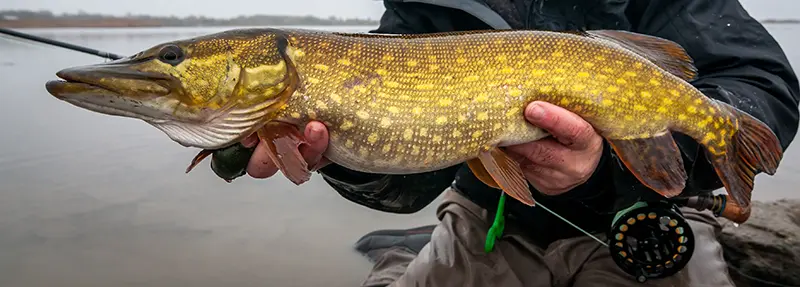
Comparing Pike to Other Fish Species
It’s clear that pike are a species apart from other fish. Especially when you’re talking about pike versus other species like muskies. But what exactly makes them different?
Predatory Behaviors and Feeding Habits
The predatory behaviors of pike can be likened to that friend who shows up uninvited at every party – they’ll eat just about anything. Muskies, on the other hand, play hard-to-get and require more effort from an angler’s side.
A fact worth noting is that pike have different feeding habits compared to muskies. While both are known for their aggressive nature, pike seem less picky with their menu choices. In contrast, catching a muskie might feel like asking a gourmet chef to approve your mom’s meatloaf recipe.
The Art of Fly Fishing: Pike vs Muskie
Fly fishing for these two species is akin to attending two very distinct dance parties; one’s free-flowing while the other demands some fancy footwork.
In terms of fly fishing techniques employed by anglers targeting either species, differences abound too. For instance, while fly fishing for muskies vs. pike, patience plays a bigger role as muskies often need repeated presentations before committing to strike.
Bite Me: Comparing Teeth and Bite Force
If teeth could tell tales then those belonging to our friends under discussion would narrate quite thrilling stories indeed. Both sport sharp gnashers but there are key distinctions between them which affect how we approach each in terms of gear setup and handling post-catch.
- Pike: They have a mouth full of razor-sharp teeth, designed to grip and hold onto their prey. This means that wire leaders are essential when fishing for pike.
- Muskies: Similar to pike in terms of dentition but generally possess larger jaws with even more pronounced canines. Dealing with them requires careful handling.
It’s like weighing up apples and oranges – every species has its own set of hurdles and perks that make the chase worthwhile.
Reviewing Essential Gear For Pike Anglers
Pike fishing is an adrenaline-fueled sport, demanding the right gear to ensure success. Let’s get into the essentials.
The Right Fly Rod for Pike Fishing
A pike rod should be sturdy enough to handle a big fish while being flexible for casting large flies. A 10wt fly rod is recommended due to its ability to withstand the pull of these muscular creatures and launch sizeable pike flies.
Your casting stroke will need some adjustments when using this heavier rod setup, but once you’ve got it down, your casts will cover more water with less effort – that means more chances at catching pike.
Fly Lines That Make a Difference
With your rod sorted out, let’s talk about fly lines. The weight of your line can significantly affect how well you cast and where in the water column your fly swims.
An intermediate sinking or floating line paired with a 10wt fly rod creates optimal conditions for enticing those elusive northern pikes lurking below surface level. Remember though: sinking rates vary depending on water temperature. In warmer waters where pikes tend to stay deeper, consider choosing a faster sink rate line.
Picking Your Pike Flies Wisely
Selecting suitable flies for pike fishing can feel like solving an elaborate puzzle; luckily we have done our homework. If smaller flies aren’t triggering bites from big meal-craving predators like pikes, switch up tactics and throw bigger patterns resembling food items they find irresistible – think bait fish, frogs or mice.
Tube fly patterns with wiggle tails and cone heads are especially effective. They imitate a wounded fish’s erratic movement that pike find irresistible. But don’t forget about topwater action flies for those exciting surface attacks.
The Unseen Hero: Leaders
A leader is an unsung hero in your gear setup, particularly when dealing with sharp-toothed predators like pike. Wire leaders offer protection against their gnarly teeth that can easily cut through regular monofilament or fluorocarbon leaders.
Our suggestion? Go for a 65lb . Trust us, it’s worth it.
FAQs in Relation to How to Start Fly Fishing for Pike
What do you need to fly fish for pike?
You’ll need a sturdy 10wt fly rod, floating or intermediate line, and a wire leader around 65lb. Don’t forget streamer flies with flash.
How do you set up a fly rod for a pike?
To rig your rod for pike, attach the reel to the butt section of your rod. Connect your backing line to the reel, add your main line then secure the leader and tie on your chosen fly.
What size fly rod should I use for pike?
A heavier 10-weight (10wt) fly fishing rod is ideal when targeting hefty predators like Pike due to their weight and aggressive nature.
When’s best time of year for pike fly fishing?
Pikes can be fished all year round but late spring into early summer are often most productive as they’re feeding heavily post-spawn.
Conclusion of How to Start Fly Fish for Pike
You’ve learned how to identify their habitats, the sunshine-loving nature of these water wolves, and the importance of shallow waters.
You now understand the gear you need. A 10wt fly rod, an intermediate line, a robust wire leader – all essential tools for catching that big northern pike.
Flies? Yes! The streamer flies with flash and action have been demystified. And remember those topwater patterns like mice and frogs? They’re your best friends on this adventure.
The art of casting and retrieval is no longer foreign. With knowledge comes power – or rather here, catch!
Safety isn’t compromised either when handling these toothy predators thanks to our guide on safety measures while fly fishing for pike.
All set then! Ready to tackle that next fishing trip with confidence knowing How to Start Fly Fishing for Pike?

